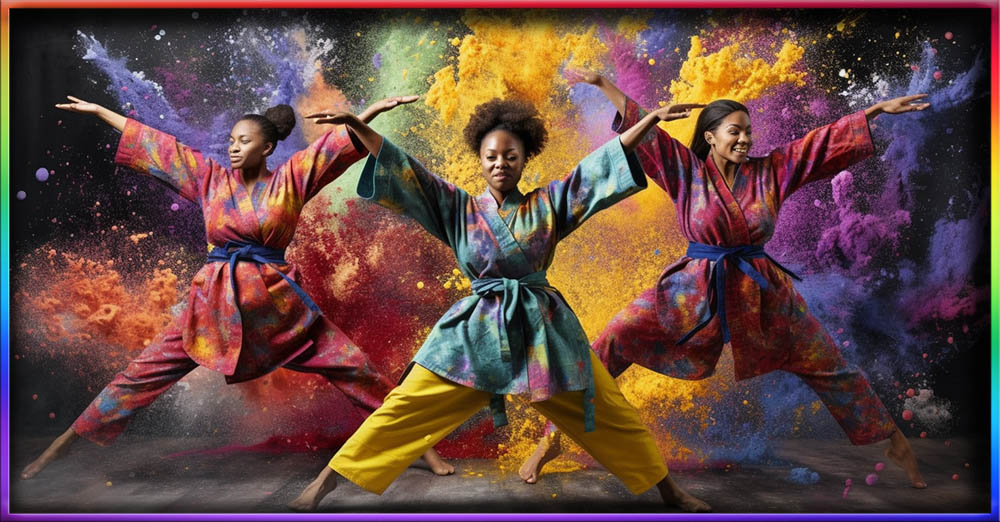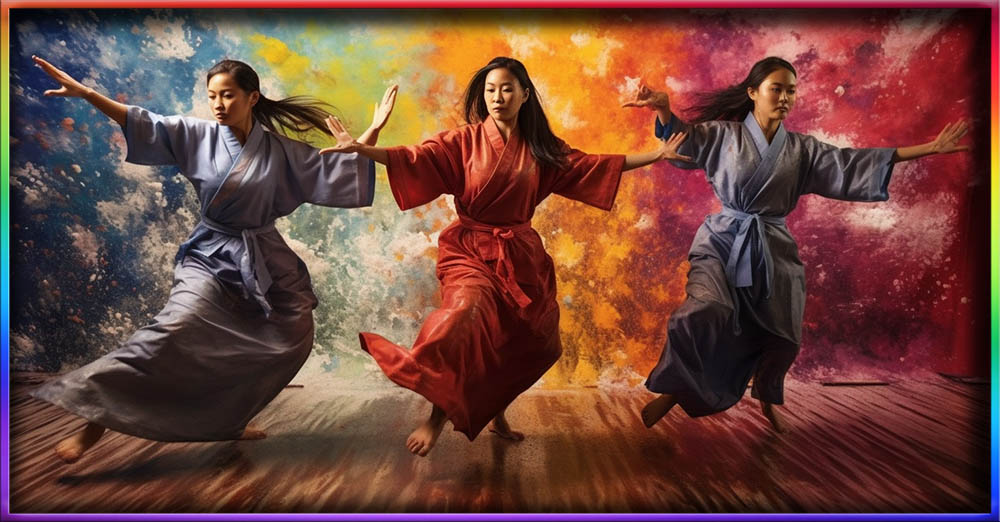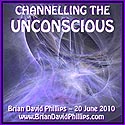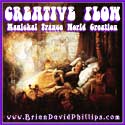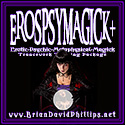
How Spontaneous Qigong Can Boost Your Well-Being
This essay includes quite a bit of discussion about energetic systems and feeling that energy flow through you. While feeling the flow is important (flow states are real, even when imagined), belief in a particular energy construct or model is not necessary to achieve positive benefits with Spontaneous Qigong (Zifagong [自发功]) . . . as my trancework students should understand, you need only feel it as if it’s real in the moment. Set aside your critical factor and FEEL IT. You need not actually believe in Qi or The Force or Orgone or Divine Presence or Elven/Fae Powers or Magick or some other construct for it to flow through you in very positive ways. Likewise, when writing this essay, I opted for comprehensive completeness over brevity. Some explanations may seem far more complicated than they are as I wished to represent the general consensus on the matter rather than merely my own view or practice. In my own personal practice, I use a very abbreviated approach. As regular readers here know, that’s one of my “things” – taking complicated occult practices and stripping away the bells and whistles and boiling them down to simple straightforward methods. I know folks who take an hour to get into the proper flow state for Spontaneous Qigong because they think the long rituals they were taught by their own teachers are the only proper way to practice it while I can use my methods and drop into flow state in just a few seconds (just as I’ve watched folks take an hour to guide someone into Energy or Kundalini orgasm when I do it in far less time – see my Youtube videos. I encourage my esoteric students to learn what I do but don’t just do what I do, synthesize knowledge and experience to build your own personal practice for your benefit.
Unleashing Inner Power
Exploring the Profound Impact of Spontaneous Qigong as an Ecstatic Trance Practice

Not too far back,I wrote a piece on shaking ecstatic trance practices and how they might be adapted to contemporary secular practice. One of the practices I mentioned – which I also practice personally and have demonstrated many times – was Spontaneous Qigong. Well, I thought it might be fun to do a deep dive so here we go,
Spontaneous Qigong, also known as Zifagong (自发功) is a fascinating practice that has gained recognition for its positive psychological, emotional, and social benefits. It represents a contemporary secular adaptation of automatistic movement spiritual experiences and ecstatic trance practices. By embracing the essence of these ancient spiritual traditions and infusing them with a modern approach, Spontaneous Qigong offers a unique avenue for individuals to cultivate well-being and self-discovery.
In its essence, Spontaneous Qigong involves allowing the body to move freely and spontaneously, guided by the natural flow of energy within. This practice encourages individuals to surrender to the wisdom of their bodies and tap into the innate power of movement as a transformative force. By engaging in this practice, practitioners can access profound psychological, emotional, and social benefits that contribute to their overall well-being.
The positive psychological impact of Spontaneous Qigong is remarkable. As individuals engage in this practice, they often experience a significant reduction in stress levels and a deep sense of relaxation. The rhythmic and flowing movements of Spontaneous Qigong help to calm the mind and release tension from the body, promoting a state of inner peace and tranquility. Moreover, the practice enhances self-awareness and mindfulness, enabling individuals to cultivate a deeper connection with their thoughts, emotions, and physical sensations. By bringing attention to the present moment, Spontaneous Qigong nurtures a sense of clarity, focus, and mental equilibrium.
Emotionally, Spontaneous Qigong acts as a powerful catalyst for self-expression and emotional regulation. Through the uninhibited movement of the body, individuals can release and channel their emotions, facilitating a healthy and cathartic release. This practice provides a safe and nurturing space for individuals to explore and express their innermost feelings, fostering emotional well-being and promoting a sense of inner harmony. By engaging in Spontaneous Qigong, practitioners often report an increased capacity for joy, happiness, and contentment, as well as improved emotional intelligence and empathy towards others.
In addition to its individual benefits, Spontaneous Qigong also holds great potential for social integration and well-being. As individuals come together to engage in this practice, a sense of community and belonging naturally emerges. The shared experience of moving and flowing in harmony cultivates a profound connection among practitioners, fostering a supportive and inclusive environment. Furthermore, Spontaneous Qigong enhances interpersonal relationships and communication skills. Through this practice, individuals learn to attune to the energy and intentions of others, leading to improved understanding, empathy, and cooperation.
Spontaneous Qigong can be seen as a contemporary secular adaptation of automatistic movement spiritual experiences and ecstatic trance practices. While traditional spiritual practices often contain religious or cultural elements, the secular approach of Spontaneous Qigong allows individuals from diverse backgrounds to engage with the practice without the need for specific beliefs or affiliations. This adaptation makes the practice accessible to a wider audience, enabling individuals to benefit from its transformative power within the context of their own lives.
Spontaneous Qigong offers profound psychological, emotional, and social benefits as a contemporary secular adaptation of automatistic movement spiritual experiences and ecstatic trance practices. This practice provides a pathway for individuals to explore their inner landscape, cultivate self-awareness, regulate emotions, and foster social connection. By embracing the essence of movement and energy flow, Spontaneous Qigong opens doors to personal growth, well-being, and a deeper understanding of oneself and others. As we delve deeper into the exploration of Spontaneous Qigong and its multifaceted benefits, we uncover the transformative potential of this practice in contemporary society.
Unlocking the Flow
Unveiling the Transformative Essence of Spontaneous Qigong

Spontaneous Qigong, when viewed through the lens of ecstatic trance practice, unveils a profound connection between movement, spirituality, and altered states of consciousness. Ecstatic trance, historically prevalent in various cultures, involves inducing trance-like states through rhythmic movement, repetitive gestures, and immersive experiences. Spontaneous Qigong aligns with this tradition by enabling practitioners to access ecstatic states through spontaneous and uninhibited movement.
In the context of ecstatic trance, Spontaneous Qigong can be understood as a means to transcend ordinary consciousness and access heightened states of awareness. By surrendering to the body’s natural impulses and allowing movement to arise spontaneously, practitioners enter a state of ecstatic flow. In this state, the boundaries of the self dissolve, and a profound connection with the present moment, the body, and the surrounding environment is experienced.
The practice of Spontaneous Qigong embodies the very essence of ecstatic trance. Through gentle swaying, rocking, and spontaneous gestures, practitioners tap into the reservoir of life energy known as Qi. The fluid and undulating movements of the body mirror the ebb and flow of the cosmic energies, leading to a harmonious dance between the individual and the universal forces. This dance awakens the ecstatic potential within, facilitating a deep sense of unity, expansiveness, and transcendence.
One of the key aspects of ecstatic trance practices is the dissolution of conscious control and the surrender to the body’s wisdom. Spontaneous Qigong embodies this principle by encouraging practitioners to let go of preconceived notions, expectations, and deliberate movements. Instead, individuals are invited to trust in the innate intelligence of their bodies and allow the spontaneous flow of movement to guide them. By relinquishing conscious control, practitioners open themselves to the transformative power of the practice, transcending ordinary limitations and entering a realm of ecstatic movement and embodied spirituality.
In the ecstatic trance state of Spontaneous Qigong, practitioners often report profound sensations, imagery, and altered states of consciousness. They may experience an enhanced sense of embodiment, feeling deeply connected to their physical bodies and the energetic forces animating them. Sensations of bliss, expansiveness, and vibrant aliveness pervade the experience, as practitioners become conduits for the Qi to flow through them. This ecstatic state transcends individual identity, leading to a sense of being part of something greater, a cosmic dance of energy and consciousness.
Spontaneous Qigong as an ecstatic trance practice holds immense potential for personal transformation, spiritual growth, and self-discovery. By entering into the ecstatic flow, practitioners can access profound insights, heightened intuition, and expanded awareness. The practice becomes a gateway to self-exploration, where the body becomes the vessel for spiritual experiences, and movement becomes a language of the soul. Through Spontaneous Qigong, individuals can touch the depths of their being, connect with universal energies, and journey into the realms of ecstatic ecstasy.
Spontaneous Qigong, when approached as an ecstatic trance practice, reveals its profound connection to movement, spirituality, and altered states of consciousness. By surrendering to spontaneous movement and embracing the ecstatic flow, practitioners enter into a transcendent state of awareness, experiencing a profound unity with the present moment, the body, and the cosmos. Through this practice, individuals can access transformative insights, expanded consciousness, and a profound sense of connection to the universal forces at play. Spontaneous Qigong as an ecstatic trance practice becomes a gateway to self-discovery, spiritual growth, and a deeper understanding of the interconnectedness of all things.
Nurturing the Mind
Harnessing the Healing Power of Spontaneous Qigong for Psychological Well-Being

Spontaneous Qigong, when practiced as an ecstatic trance, offers a wealth of positive psychological benefits that contribute to overall well-being and mental health. This transformative practice has been shown to reduce stress, enhance self-awareness, improve cognitive functions, and foster emotional intelligence, making it a powerful tool for psychological growth and resilience.
One of the primary psychological benefits of Spontaneous Qigong as an ecstatic trance practice is stress reduction. Engaging in rhythmic, flowing movements and entering the ecstatic flow state helps individuals release tension and calm the mind. The repetitive and soothing nature of the practice induces a relaxation response, activating the parasympathetic nervous system and reducing the physiological effects of stress. Through this process, practitioners experience a sense of inner peace, tranquility, and a restoration of balance in their emotional and psychological well-being.
Spontaneous Qigong also promotes self-awareness and mindfulness, which are integral to psychological health. By engaging in this practice, individuals cultivate a deeper connection with their bodies, thoughts, and emotions. The spontaneous movement allows practitioners to tune in to the subtle sensations and energetic flow within, fostering a heightened sense of body awareness and present-moment focus. This increased self-awareness not only enhances the practice itself but also carries over to daily life, as individuals become more attuned to their needs, emotions, and the world around them.
Furthermore, the practice of Spontaneous Qigong as an ecstatic trance has been found to improve cognitive functions and memory. The rhythmic movements, combined with the heightened state of awareness, stimulate neural activity and enhance brain function. Studies have shown that regular practice of Spontaneous Qigong can improve concentration, mental clarity, and cognitive flexibility. This cognitive enhancement extends beyond the practice itself, positively influencing various aspects of daily life, such as decision-making, problem-solving, and creative thinking.
Another significant psychological benefit of Spontaneous Qigong is the development of emotional intelligence and empathy. By engaging in this practice, individuals learn to embody and express their emotions freely, allowing for emotional release and regulation. The practice provides a safe and non-judgmental space for individuals to explore their emotional landscape, promoting emotional well-being and a deeper understanding of their own feelings. Moreover, the sense of interconnectedness and unity experienced in the ecstatic flow state cultivates empathy and compassion towards others, fostering healthier interpersonal relationships and social interactions.
Spontaneous Qigong, when practiced as an ecstatic trance, offers substantial positive psychological benefits. The practice reduces stress, enhances self-awareness and mindfulness, improves cognitive functions, and develops emotional intelligence and empathy. By engaging in this transformative practice, individuals experience a sense of inner peace, heightened cognitive abilities, and improved emotional well-being. Spontaneous Qigong as an ecstatic trance practice becomes a powerful tool for personal growth, psychological resilience, and the cultivation of a harmonious mind-body connection.
Embracing Emotions
Empowering the Heart through Spontaneous Qigong as an Ecstatic Trance Practice

Spontaneous Qigong, when embraced as an ecstatic trance practice, offers profound positive emotional benefits that contribute to emotional well-being, self-expression, and inner harmony. This transformative practice allows individuals to release pent-up emotions, cultivate joy and happiness, develop emotional resilience, and experience a deep sense of emotional connection and authenticity.
One of the primary emotional benefits of Spontaneous Qigong as an ecstatic trance practice is the cathartic release of emotions. Through the uninhibited and spontaneous movement of the body, individuals can express and release emotions that may be otherwise suppressed or repressed. The practice provides a safe and non-judgmental space for individuals to let go of emotional baggage, allowing emotions to flow freely and be transformed. This cathartic release not only brings relief but also fosters emotional healing, leading to a greater sense of emotional balance and well-being.
Engaging in Spontaneous Qigong often elicits feelings of joy, happiness, and contentment. The rhythmic and flowing movements, combined with the ecstatic state of consciousness, create a sense of aliveness and vibrancy. As practitioners surrender to the spontaneous flow of movement, they tap into the wellspring of joy within, experiencing a profound connection with their inner selves and the present moment. This joyful experience can have a lasting impact, permeating into other areas of life and fostering a positive emotional outlook.
Spontaneous Qigong also promotes emotional resilience by fostering a deeper understanding and acceptance of one’s emotions. Through the practice, individuals develop a heightened awareness of their emotional landscape, becoming attuned to the subtle shifts and nuances of their feelings. This increased emotional intelligence enables practitioners to navigate and regulate their emotions more effectively, promoting emotional stability and resilience in the face of challenges and stressors. The practice serves as a powerful tool for emotional self-care and empowerment.
Furthermore, Spontaneous Qigong facilitates a deep sense of emotional connection and authenticity. As individuals surrender to the ecstatic flow and express themselves through spontaneous movement, they tap into their authentic emotions and embody their true selves. This practice allows for a release of emotional masks and societal conditioning, fostering a genuine expression of emotions and an alignment with one’s true nature. By cultivating emotional authenticity, individuals experience a greater sense of self-acceptance, inner harmony, and emotional congruence.
Spontaneous Qigong, as an ecstatic trance practice, brings forth significant positive emotional benefits. The practice allows for the cathartic release of emotions, cultivates joy and happiness, develops emotional resilience, and fosters emotional connection and authenticity. Through Spontaneous Qigong, individuals can find emotional healing, balance, and a deeper understanding of their emotional landscape. This practice becomes a transformative pathway for emotional well-being, self-expression, and a profound sense of inner harmony.
Building Bridges of Connection
Cultivating Community and Empathy through Spontaneous Qigong

Spontaneous Qigong, when practiced as an ecstatic trance, not only offers individual benefits but also fosters positive social interactions and community engagement. This transformative practice promotes social integration, empathy, and cooperation, creating a supportive and inclusive environment that nurtures social connections and well-being.
One of the primary social benefits of Spontaneous Qigong as an ecstatic trance practice is the sense of community it cultivates. As individuals come together to engage in this practice, a shared experience of movement, energy, and connection emerges. The collective engagement in spontaneous movement creates a profound sense of unity and togetherness. This shared experience fosters a supportive and inclusive community where individuals feel a sense of belonging and connection with like-minded practitioners. The practice of Spontaneous Qigong becomes a bridge that brings people together, transcending barriers and creating a space for authentic connection.
Spontaneous Qigong enhances interpersonal relationships and communication skills. Through this practice, individuals learn to attune to the energy and intentions of others, creating a heightened sense of empathy and understanding. The ecstatic trance state experienced during Spontaneous Qigong opens individuals to a deep level of connection with others, transcending words and fostering non-verbal communication. As individuals engage in spontaneous movements together, they develop a unique form of communication that is based on energetic resonance and mutual harmony. This enhances empathy, cooperation, and compassion towards others, leading to healthier and more fulfilling relationships.
The practice of Spontaneous Qigong as an ecstatic trance can also contribute to social well-being by fostering a sense of collective energy and shared intention. As practitioners synchronize their movements and enter the ecstatic flow state together, a collective energy field is created. This shared energetic resonance amplifies the positive effects of the practice and creates a powerful sense of unity among participants. The collective intention of cultivating well-being and self-discovery becomes a focal point that unites individuals and generates a supportive and uplifting social atmosphere.
Furthermore, Spontaneous Qigong offers a unique platform for cultural exchange and understanding. As an adaptable and inclusive practice, it attracts individuals from diverse backgrounds and cultures. Through the shared practice of Spontaneous Qigong, participants have the opportunity to learn from each other, exchange experiences, and gain a deeper appreciation for different perspectives and traditions. This cultural exchange fosters a sense of mutual respect, appreciation, and interconnectedness, creating a rich and diverse social tapestry.
Spontaneous Qigong, when practiced as an ecstatic trance, brings forth significant positive social benefits. It cultivates a sense of community and belonging, enhances interpersonal relationships and communication skills, fosters collective energy and shared intention, and promotes cultural exchange and understanding. Through this practice, individuals not only experience personal growth and well-being but also contribute to the creation of a supportive and inclusive social environment. Spontaneous Qigong becomes a catalyst for social integration, empathy, and cooperation, nurturing social connections and fostering a sense of shared purpose and unity among practitioners.
Harmony of Body and Spirit
Uniting Ancient Wisdom with Modern Adaptation through Spontaneous Qigong
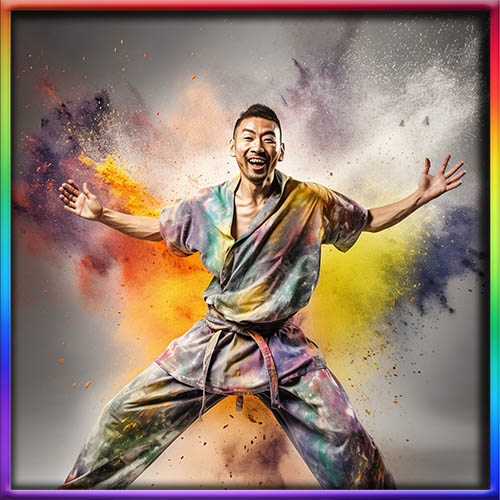
Spontaneous Qigong represents a contemporary secular adaptation of automatistic movement spiritual experiences and ecstatic trance practices, bridging ancient wisdom with modern perspectives. Drawing inspiration from the rich tradition of automatistic movement practices found in various spiritual and religious contexts, Spontaneous Qigong offers a non-dogmatic and accessible approach to ecstatic trance, making it relevant and applicable to individuals from diverse backgrounds.
Automatistic movement spiritual experiences have long been recognized as a means of connecting with the divine, transcending the ordinary self, and accessing altered states of consciousness. Spontaneous Qigong inherits the essence of these traditions while embracing a contemporary and secular framework. It provides individuals with a platform to engage in spontaneous, uninhibited movement without requiring adherence to specific religious or spiritual beliefs. By offering a non-dogmatic approach, Spontaneous Qigong allows practitioners to explore the transformative potential of automatistic movement in a way that aligns with their personal beliefs and values.
As a secular adaptation, Spontaneous Qigong remains rooted in the fundamental principles of automatistic movement practices. The practice involves surrendering to the body’s natural impulses, allowing movements to arise spontaneously, and entering a state of ecstatic flow. This flow state, characterized by a dissolution of the ego and a deep connection with the present moment, mirrors the transcendent experiences sought in spiritual contexts. By secularizing the practice, Spontaneous Qigong becomes accessible to a wider audience, enabling individuals to tap into the transformative power of automatistic movement without the confines of specific religious or spiritual frameworks.
Moreover, as a secular practice, Spontaneous Qigong embraces scientific inquiry and evidence-based approaches. While acknowledging the subjective and experiential nature of the practice, it encourages research and empirical investigation into its effects on psychological, physiological, and emotional well-being. By bridging the gap between ancient wisdom and modern understanding, Spontaneous Qigong opens the door for scientific exploration of ecstatic trance experiences, offering opportunities for further understanding and potential integration with contemporary therapeutic modalities.
The secular adaptation of automatistic movement spiritual experiences in Spontaneous Qigong also highlights the universality of the human experience. Regardless of cultural, religious, or spiritual background, individuals possess an innate capacity for ecstatic states and transcendent experiences. Spontaneous Qigong provides a framework for individuals to tap into this universal aspect of human nature and connect with their inner selves, the present moment, and the cosmic forces at play. It transcends specific belief systems, emphasizing the common threads that unite humanity in the quest for spiritual connection and self-discovery.
Spontaneous Qigong represents a contemporary secular adaptation of automatistic movement spiritual experiences and ecstatic trance practices. It offers a non-dogmatic approach to engage in spontaneous movement and enter an ecstatic flow state, mirroring the essence of ancient traditions. By embracing a secular framework, Spontaneous Qigong makes this transformative practice accessible to individuals from diverse backgrounds, allowing them to explore the profound potential of automatistic movement within their own belief systems. The secular adaptation also encourages scientific inquiry and emphasizes the universality of the human experience, fostering a deeper understanding of the transformative power of ecstatic trance in contemporary contexts.
Awakening the Soul’s Dance
Embarking on a Journey of Ecstasy through Spontaneous Qigong

Spontaneous Qigong stands as a powerful form of ecstatic trance practice, offering a transformative and immersive experience for individuals seeking deeper connection, self-exploration, and spiritual growth. Rooted in the ancient tradition of Qigong, this practice combines the elements of spontaneous movement, breathwork, and energetic awareness to facilitate a state of heightened consciousness and profound inner transformation.
At its core, Spontaneous Qigong is a practice of surrendering to the body’s natural wisdom and allowing movements to arise spontaneously. By releasing the constraints of conscious control, individuals tap into a deeper reservoir of innate energy and intuitive guidance. The movements that emerge during Spontaneous Qigong are not premeditated or directed by external influences but rather flow from the interplay of the body, breath, and the universal life force known as Qi. This process allows practitioners to enter a state of ecstatic trance, where the ordinary boundaries of the self dissolve, and a direct connection with the divine and the energetic fabric of existence is established.
The practice of Spontaneous Qigong engages the entire being—mind, body, and spirit—in a harmonious and integrated way. The fluid and spontaneous movements awaken and circulate Qi throughout the body, clearing energetic blockages and promoting vitality and well-being. This activation of Qi facilitates a deeper sense of self-awareness, allowing individuals to explore their inner landscape, emotions, and energetic patterns. The ecstatic trance state reached through Spontaneous Qigong serves as a gateway to expanded consciousness, facilitating profound experiences of unity, transcendence, and spiritual awakening.
Through the practice of Spontaneous Qigong, individuals gain a direct experiential understanding of the interconnectedness of all things. The ecstatic flow of movement aligns the individual’s energy with the greater cosmic forces at play, creating a sense of unity and interconnectedness with the web of life. This experience transcends the boundaries of the individual self, offering a glimpse into the vastness of existence and a profound sense of belonging to something greater than oneself. In this state of ecstatic trance, individuals often report feelings of profound peace, bliss, and a deep connection with the divine or universal consciousness.
Spontaneous Qigong serves as a catalyst for personal transformation and self-discovery. By surrendering to the spontaneous movements and the wisdom of the body, individuals access deeper layers of their being, unlocking dormant potentials and releasing energetic stagnation. The practice can bring to the surface unresolved emotions, traumas, and limiting beliefs, providing an opportunity for healing and integration. Through regular engagement in Spontaneous Qigong as an ecstatic trance practice, individuals embark on a journey of self-exploration, self-empowerment, and spiritual evolution.
Spontaneous Qigong emerges as a profound and transformative ecstatic trance practice. Through the spontaneous and fluid movements, individuals access a state of heightened consciousness, unity with the divine, and deep self-awareness. This practice enables the activation and circulation of Qi, fostering vitality and well-being on all levels. As individuals surrender to the wisdom of the body and engage in the ecstatic flow, they experience personal transformation, expanded consciousness, and a profound sense of connection with the universe. Spontaneous Qigong stands as a gateway to self-discovery, spiritual growth, and the realization of our interconnectedness with the greater tapestry of existence.
Understanding Ecstatic Trance and its Historical Context

To fully grasp the significance of Spontaneous Qigong as an ecstatic trance practice, it is essential to delve into the concept of ecstatic trance and its historical context. Ecstatic trance refers to a profound altered state of consciousness characterized by intense immersion, heightened awareness, and a deep connection with the spiritual or divine realm. This transcendent state has been sought and experienced by individuals across cultures and throughout history as a means of spiritual exploration, healing, and communion with the sacred.
The roots of ecstatic trance can be traced back to ancient civilizations and indigenous cultures, where it was often intertwined with religious rituals, shamanic practices, and mystical traditions. In these contexts, ecstatic trance served as a doorway to commune with the divine, access spiritual realms, and receive guidance or healing. It involved various techniques such as rhythmic dancing, repetitive movements, chanting, drumming, and breathwork to induce an altered state of consciousness.
Historically, ecstatic trance has been observed in diverse cultural and spiritual practices. For example, the Sufis, followers of the mystical branch of Islam, engage in whirling dances known as Sufi whirling to induce a state of trance and spiritual ecstasy. The Dervishes, renowned for their spinning rituals, aim to transcend the ego and achieve a union with the divine through ecstatic movement. Similarly, in many indigenous cultures, rituals involving trance states are employed for healing, divination, and communication with ancestral spirits.
In the context of Qigong, ecstatic trance has been explored through various movement-based practices, including Spontaneous Qigong. Qigong, an ancient Chinese discipline, encompasses a wide range of practices that integrate movement, breath control, and meditative techniques to cultivate Qi, the vital life force. Ecstatic trance experiences have long been recognized within the Qigong tradition as a pathway to spiritual growth, self-realization, and healing.
By understanding the historical context of ecstatic trance, we can appreciate how Spontaneous Qigong builds upon this rich legacy. Spontaneous Qigong represents a contemporary adaptation of these ancient practices, incorporating the wisdom of ecstatic trance into a modern framework. While rooted in the historical and cultural tapestry of spiritual practices, Spontaneous Qigong embraces a secular approach, making it accessible to individuals from diverse backgrounds who seek personal growth, well-being, and self-discovery.
Ecstatic trance has a profound historical context that spans across cultures and spiritual traditions. It has been employed as a means of connecting with the divine, accessing altered states of consciousness, and facilitating healing. Spontaneous Qigong draws inspiration from this historical background, combining the wisdom of ecstatic trance with the principles of Qigong. By understanding the historical significance of ecstatic trance, we can appreciate the depth and transformative potential of Spontaneous Qigong as a contemporary adaptation of this ancient practice.
Introduction to Spontaneous Qigong as a Practical Ecstatic Trance Practice

Spontaneous Qigong emerges as a unique and powerful form of ecstatic trance practice within the broader landscape of Qigong disciplines. Rooted in the principles of Qigong, this practice invites individuals to engage in spontaneous and uninhibited movement, enabling them to enter a state of ecstatic trance and tap into the profound transformative potential of their own energy.
At its core, Spontaneous Qigong emphasizes the cultivation and circulation of Qi, the vital life force that flows through the body. Unlike other forms of Qigong that follow prescribed movements or sequences, Spontaneous Qigong encourages practitioners to surrender to the innate wisdom of their bodies, allowing movements to arise naturally and spontaneously. Through this practice, individuals access a state of ecstatic trance where the boundaries of the conscious self dissolve, and a direct connection with the energetic forces of the universe is established.
The practice of Spontaneous Qigong begins by cultivating a state of deep relaxation and internal focus. Through gentle breathwork, meditation, and gentle stretching exercises, practitioners become attuned to the present moment and the sensations within their bodies. As the practitioner enters a state of heightened awareness and receptivity, spontaneous movements start to emerge organically, guided by the inner flow of Qi and the body’s intuitive wisdom.
During Spontaneous Qigong, the movements may vary from slow and graceful to vigorous and expressive, encompassing a wide range of gestures, postures, and rhythmic patterns. These movements are not consciously controlled but arise from the interaction of the body, breath, and the underlying Qi energy. By surrendering to these spontaneous movements, individuals tap into the transformative power of ecstatic trance, experiencing a deep sense of liberation, expansion, and connection with the universal flow of energy.
One of the distinguishing features of Spontaneous Qigong as an ecstatic trance practice is the emphasis on self-expression and inner exploration. Each individual’s experience of Spontaneous Qigong is unique, as it allows for the unrestricted expression of their authentic selves. The movements that arise during practice may reflect emotions, energetic imbalances, or deep-seated patterns held within the body. By observing and engaging with these movements, individuals gain insights into their emotional and energetic landscapes, facilitating healing, release, and transformation.
Furthermore, Spontaneous Qigong serves as a bridge between the physical, emotional, and spiritual dimensions of our being. The spontaneous movements activate and circulate Qi throughout the body, promoting physical vitality and well-being. Simultaneously, the practice engages the emotions, providing a safe space for the release of stagnant or suppressed feelings. This integration of body, emotions, and spirit allows for a holistic and transformative experience, fostering personal growth, balance, and alignment.
Spontaneous Qigong represents a unique and powerful form of ecstatic trance practice within the realm of Qigong disciplines. Through the cultivation of Qi and the surrender to spontaneous movements, practitioners enter a state of ecstatic trance, connecting with the universal flow of energy and experiencing profound transformation on physical, emotional, and spiritual levels. Spontaneous Qigong embraces self-expression, inner exploration, and the integration of body, emotions, and spirit. By engaging in this practice, individuals embark on a journey of self-discovery, liberation, and connection with the boundless potential of their own energy.
Preparing for Spontaneous Qigong Practice as an Ecstatic Trance Practice

Preparing for Spontaneous Qigong practice is crucial to creating a supportive and conducive environment for engaging in ecstatic trance. By establishing the right conditions, practitioners can deepen their connection with their bodies, cultivate a focused mindset, and enhance their overall experience of Spontaneous Qigong as an ecstatic trance practice.
One essential aspect of preparation involves creating a physical space that promotes relaxation and focus. Choose a quiet and clutter-free area where you can move freely without any distractions. Consider elements like soft lighting, soothing music, or natural surroundings to create an ambiance conducive to inner exploration and energetic connection. Ensure that the space is comfortable, well-ventilated, and allows for unrestricted movement.
Before commencing Spontaneous Qigong, it is beneficial to engage in a warm-up routine that prepares the body for the spontaneous and expressive movements to come. Gentle stretching exercises, joint rotations, and deep breathing techniques help to release tension, increase flexibility, and awaken the body’s energy centers. This warm-up phase promotes physical readiness, improves body awareness, and enhances the flow of Qi throughout the body.
Setting intentions and cultivating a focused mindset are fundamental aspects of preparing for Spontaneous Qigong practice. Take a few moments to reflect on your purpose for engaging in the practice. Clarify your intentions, whether it is self-exploration, emotional release, spiritual connection, or personal transformation. Set clear and positive intentions that resonate with your personal goals and values. This mental preparation creates a sense of purpose and direction, aligning your energy and focus for the upcoming practice.
Another crucial element of preparation involves grounding and centering oneself. Take a few moments to connect with your breath, bring your awareness into your body, and establish a sense of presence in the present moment. Grounding techniques such as visualizing roots extending from your feet into the earth or feeling the support of the ground beneath you help establish stability and a strong foundation. Centering practices, such as focusing on the area just below the navel (the lower dantian), help bring your energy and attention to the core of your being, fostering balance and inner harmony.
Additionally, it is essential to cultivate a mindset of openness, curiosity, and non-judgment. Spontaneous Qigong invites the emergence of movements that are unique to each individual, and it is important to approach these movements with a sense of exploration and acceptance. Release any expectations or preconceived notions about how the practice should unfold and trust in the innate wisdom of your body. Embrace any sensations, emotions, or experiences that arise during the practice with an open and non-judgmental attitude.
Thorough preparation for Spontaneous Qigong practice sets the stage for a deep and transformative experience of ecstatic trance. Creating a supportive physical environment, engaging in a warm-up routine, setting intentions, grounding and centering oneself, and cultivating an open mindset are essential elements of preparation. By dedicating time and attention to these preparatory steps, practitioners can optimize their engagement with Spontaneous Qigong, deepening their connection with their bodies, and creating a space for profound self-exploration, healing, and spiritual growth.
Basic Techniques and Movements in Spontaneous Qigong
How to Practice Spontaneous Qigong as an Ecstatic Trance Practice

Spontaneous Qigong as an ecstatic trance practice encompasses a wide range of techniques and movements that facilitate the flow of Qi and induce a state of ecstatic trance. Understanding the basic techniques and how to practice Spontaneous Qigong is essential for individuals seeking to engage in this transformative practice.
Breathwork: Breathwork forms a foundational component of Spontaneous Qigong practice. Start by focusing on slow, deep abdominal breathing, allowing the breath to flow naturally and effortlessly. Conscious breathing helps to calm the mind, increase oxygenation, and activate the body’s energy centers.
Body Awareness: Develop a heightened sense of body awareness as you embark on Spontaneous Qigong practice. Cultivate an attitude of deep listening to the sensations, movements, and energetic shifts within your body. By bringing conscious attention to different parts of the body, you become attuned to the subtle signals and messages that arise during the practice.
Spontaneous Movements: In Spontaneous Qigong, movements arise naturally and spontaneously, guided by the body’s innate wisdom and the flow of Qi. Allow your body to move freely and expressively without conscious control or judgment. Embrace a state of surrender, trusting that the movements that emerge are precisely what your body needs for healing, release, and transformation.
Energetic Visualization: Incorporate energetic visualization techniques to enhance your Spontaneous Qigong practice. Visualize the flow of Qi within your body, imagining it as a vibrant and luminous energy. As you move, visualize the Qi circulating, harmonizing, and clearing any blockages or stagnant energy, allowing for a smooth and balanced flow.
Grounding and Centering: Grounding and centering techniques are vital for maintaining stability and focus during Spontaneous Qigong practice. Visualize roots extending from your feet deep into the earth, anchoring you and providing a sense of stability. Center your awareness on the lower dantian, a point located just below the navel, to cultivate a deep sense of inner balance and harmony.
To practice Spontaneous Qigong as an ecstatic trance practice, create a dedicated space free from distractions. Begin by engaging in a gentle warm-up routine to prepare your body and mind. Deepen your breath, stretch your muscles, and loosen any tension held in the body. Once warmed up, enter a relaxed and meditative state, focusing on your breath and centering your awareness.
Allow your body to move spontaneously, without predetermined patterns or sequences. Surrender to the flow of Qi and the natural intelligence of your body. Explore different movements—slow or fast, fluid or rhythmic—and let go of any inhibitions or self-consciousness. Embrace the full expression of your body, allowing it to release any stored tension, emotions, or energetic blockages.
Throughout the practice, maintain a state of mindful presence, observing the sensations, emotions, and energetic shifts that arise. Cultivate an attitude of acceptance, non-judgment, and curiosity, embracing whatever emerges during the practice. Stay connected with your breath, using it as a anchor to remain centered and connected with the present moment.
After the practice, take time for integration and reflection. Rest in stillness, allowing the energy to settle and integrate within your body. Journaling or contemplative practices can help deepen your understanding of the experiences and insights that may have emerged during the practice.
My Personal Method
As many of my trancework students know, my personal approach to Spontaneous Qigong (Zifagong [自发功]) is fairly straightforward and typically only takes as little as five seconds to be in flow state.
I plant myself, standing in a comfortable safe space. I don’t use a lot of space but some folks use more, depending upon how much foot movement they experience (you simply tell yourself to stay planted or within the confines of your area of practice and usually all is good. I then drop into trance and flow state by holding my arms up and breathing deeply for a few deep breaths then release my arms and let them move. It should feel as if your arms, hands, body are moving of their own accord with no conscious direction. Continue trancework style deep breathing to deepen the state as you continue with the practice – find a balance between deep breathing (belly breathing) and movement practice – it may seem tricky at first, but you should find it fairly quickly.
FEEL THE ENERGETIC FLOW BREATHING THROUGH YOU – make it a visceral visualization experience.
Your eyes can be open or closed. It’s up to you. Some folks find eyes closed makes it easier to surrender to the flow. Others want to manage their environment with eyes open. It’s pretty much whatever works for you that matters.
When you wish to terminate the trance and the session, just will yourself to stop and emerge.
That’s pretty much it.
Some folks like to add rider trance states. For instance, when I first learned the process in Taiwan, I learned to visualize the energetic essence of an animal spirit flowing through me which colors the experience. A slew of folks use the drunken process to create an inebriated flow experience for themselves (yes, see all those drunken master films and be sure to watch my umpteen-million videos of drunken hypnosis and the like (other drug effects work too). Others visualize connection to the divine. Since, I am known in some circles as “the erotic trance guy” I have adapted it with very good effect to therapeutic erotic trancework,
See some of my videos for other examples.
Give it a go and experiment to your own tastes.
Spontaneous Qigong as an ecstatic trance practice involves breathwork, body awareness, spontaneous movements, energetic visualization, grounding, and centering. To practice Spontaneous Qigong, create a dedicated space, engage in a warm-up routine, enter a relaxed state, and allow your body to move spontaneously. Maintain mindfulness, acceptance, and curiosity throughout the practice, and take time for integration afterward. By embodying these techniques and approaches, individuals can unlock the transformative power of Spontaneous Qigong and experience the profound effects of ecstatic trance on their physical, emotional, and spiritual well-being.
Facilitating the Ecstatic Trance State in Spontaneous Qigong as an Ecstatic Trance Practice

Facilitating the ecstatic trance state is a central objective of Spontaneous Qigong practice. It is within this state that practitioners can tap into the deep reservoirs of their inner wisdom, access heightened states of consciousness, and experience profound transformation. Understanding the key elements that facilitate the ecstatic trance state in Spontaneous Qigong is crucial for practitioners seeking to delve into the depths of their being.
Intention and Surrender: Set a clear intention to enter into an ecstatic trance state during your Spontaneous Qigong practice. Release any expectations or attachments to specific outcomes and surrender to the flow of the practice. Cultivate a mindset of openness and receptivity, allowing the body’s innate wisdom and the flow of Qi to guide your movements and experiences.
Rhythmic and Repetitive Movements: Engaging in rhythmic and repetitive movements can facilitate the induction of the ecstatic trance state. These movements create a hypnotic effect, allowing the mind to relax and enter into a state of heightened receptivity. By repeating certain gestures or patterns, practitioners can deepen their focus, induce a trance-like state, and access altered states of consciousness.
Breathwork and Sound: Conscious control of the breath and the use of sound can be powerful tools for facilitating the ecstatic trance state. Deep, rhythmic breathing helps to calm the mind, activate the body’s energy centers, and enhance the flow of Qi. Incorporating vocalizations, chants, or toning can amplify the energetic vibrations within the body, deepening the trance state and facilitating a greater connection with the spiritual dimensions.
Sensory Stimulation: Engaging the senses can play a vital role in facilitating the ecstatic trance state. Utilize visualizations, imagery, or the focus on specific objects to enhance concentration and induce a state of absorption. Incorporate music or rhythmic sounds that resonate with your intentions and evoke the desired emotional states. By activating multiple senses, practitioners can create a rich and immersive experience that supports the journey into ecstatic trance.
Energy Awareness and Circulation: Developing a heightened awareness of the body’s energy and facilitating its circulation are fundamental for entering the ecstatic trance state. Through mindfulness and focused attention, practitioners can sense the subtle movements of Qi within their bodies. Intentionally directing and circulating the energy through specific energy channels or meridians can deepen the trance state, activate dormant potentials, and awaken higher states of consciousness.
Ritual and Sacred Space: Creating a ritualistic and sacred space can greatly facilitate the induction of the ecstatic trance state. Establishing a clear and intentional framework for the practice helps to create a container for deepening focus and opening to spiritual dimensions. Incorporate elements such as lighting candles, burning incense, or creating an altar to honor the sacredness of the practice and invite a sense of reverence and transcendence.
Practice and Patience: Facilitating the ecstatic trance state requires consistent practice and patience. As with any transformative practice, it takes time to deepen into the experience and develop a profound connection with the ecstatic trance state. Embrace the journey and allow for exploration, experimentation, and refinement of your approach. With dedicated practice, the ecstatic trance state becomes more accessible and transformative.
Facilitating the ecstatic trance state in Spontaneous Qigong involves setting intentions, surrendering to the practice, engaging in rhythmic movements, utilizing breathwork and sound, incorporating sensory stimulation, cultivating energy awareness, creating a sacred space, and embracing a patient and dedicated approach. By integrating these elements into their practice, individuals can facilitate the induction of the ecstatic trance state, accessing profound states of consciousness, and experiencing deep transformation and spiritual connection through Spontaneous Qigong.
Synchronizing the Divine Connection
Exploring the Intersection of Spirituality and Spontaneous Qigong

Spontaneous Qigong, as an ecstatic trance practice, can be a deeply personal and transformative experience. For individuals who already have a religious or spiritual framework, integrating Spontaneous Qigong into their existing practice can enhance their connection with their beliefs and deepen their spiritual journey. By combining their religious or spiritual framework with Spontaneous Qigong, practitioners can explore new dimensions of their faith, foster a deeper sense of connection, and experience profound spiritual growth.
Honoring Diversity: One of the strengths of Spontaneous Qigong is its flexibility and adaptability. It can be practiced by individuals from various religious or spiritual backgrounds. When combining Spontaneous Qigong with a religious or spiritual framework, it is important to honor and respect the diversity of beliefs. Recognize that each person’s experience may be unique and deeply personal, and that different interpretations and expressions of spirituality are valid.
Intention Setting: Before engaging in Spontaneous Qigong, practitioners can set intentions that align with their religious or spiritual beliefs. This can involve dedicating the practice to a higher power, seeking guidance or wisdom from specific deities or spiritual figures, or aligning the practice with the core principles of their faith. By consciously infusing their practice with their religious or spiritual intentions, practitioners can deepen their connection and create a sacred space for their ecstatic trance experience.
Rituals and Symbolism: Incorporating rituals and symbolism from one’s religious or spiritual tradition can add depth and meaning to the practice of Spontaneous Qigong. This can include using sacred objects, performing prayers or mantras, or invoking specific symbols or gestures that hold significance in their faith. By infusing their practice with these elements, practitioners can tap into the power of symbolism and draw upon the rich spiritual heritage of their tradition.
Prayer and Meditation: Integrating prayer and meditation into Spontaneous Qigong allows practitioners to deepen their spiritual connection and engage in a dialogue with the divine. Before, during, or after the practice, individuals can engage in prayer or meditation techniques that align with their religious or spiritual beliefs. This can involve expressing gratitude, seeking guidance, or simply cultivating a state of reverence and openness to divine presence.
Reflective Contemplation: Following each session of Spontaneous Qigong, practitioners can engage in reflective contemplation, drawing upon the teachings of their religious or spiritual framework. This can involve journaling, reading sacred texts, or engaging in contemplative practices that allow for deeper insights and self-reflection. By combining the wisdom of their tradition with the experiences and insights gained from Spontaneous Qigong, practitioners can integrate their ecstatic trance experiences into their overall spiritual journey.
Seek Guidance from Spiritual Leaders: For individuals who wish to combine their religious or spiritual framework with Spontaneous Qigong, seeking guidance from spiritual leaders within their tradition can be valuable. These leaders can provide insights, offer perspective, and help practitioners navigate the integration process. They can provide guidance on how to align the practice with the principles and teachings of their faith, ensuring a harmonious integration of ecstatic trance experiences within their spiritual journey.
Combining one’s religious or spiritual framework with Spontaneous Qigong as an ecstatic trance practice allows individuals to deepen their connection to their beliefs, enhance their spiritual journey, and experience profound growth. By honoring diversity, setting intentions, incorporating rituals and symbolism, engaging in prayer and meditation, practicing reflective contemplation, and seeking guidance from spiritual leaders, practitioners can create a harmonious integration of their ecstatic trance experiences within their religious or spiritual framework. This integration offers a transformative path that allows individuals to tap into the
Spontaneous Qigong as Erotic Trance Practice

Adapting Spontaneous Qigong as an ecstatic trance practice to erotic trance practice holds significant therapeutic potential for clients seeking a holistic approach to healing and self-discovery. Erotic trance, when facilitated within a safe and consensual framework, can provide a transformative space for individuals to explore and integrate their sensual energy. By incorporating elements of Spontaneous Qigong into the practice, therapists can harness the inherent mind-body connection and tap into the profound benefits of both modalities.
In this adapted approach, the focus shifts towards cultivating a deep connection with one’s sensual self and embracing erotic energy as a powerful catalyst for personal growth. Therapeutic clients engage in fluid and spontaneous movements, guided by breath and intention, to facilitate an ecstatic trance state that opens pathways to self-exploration and healing. The combination of Spontaneous Qigong techniques, such as flowing movements and mindful breathing, with the intentional exploration of erotic energy allows individuals to tap into their body’s wisdom, release emotional blockages, and foster self-acceptance.
For therapeutic clients, this adaptation of Spontaneous Qigong as erotic trance practice can offer a unique opportunity to address issues related to body image, shame, trauma, and sexual expression. The ecstatic trance state accessed through the practice allows individuals to enter a non-judgmental, non-linear space where the body and mind are free to express and explore sensual energy without societal constraints. By cultivating a safe and supportive environment, therapists can guide clients in reconnecting with their authentic desires, healing past wounds, and transforming their relationship with their own sexuality.
The integration of Spontaneous Qigong and erotic trance practice in therapy promotes self-awareness, embodiment, and emotional release. Through this holistic approach, clients can experience a heightened sense of pleasure, self-acceptance, and empowerment. The combined elements of movement, breath, and intention enable individuals to tap into their innate erotic wisdom, facilitating a profound connection with their sensual self and allowing for a deeper understanding of their unique desires and boundaries.
It is important to note that the adaptation of Spontaneous Qigong to erotic trance practice for therapeutic clients requires skilled and ethical guidance from trained professionals. Therapists must create a safe and consensual space, establish clear boundaries, and ensure ongoing communication and consent throughout the process. Respect for individual boundaries, trauma-informed practices, and a client-centered approach are essential in working with clients in this capacity.
Overall, adapting Spontaneous Qigong as an ecstatic trance practice to erotic trance practice for therapeutic clients can be a transformative and empowering modality. By incorporating elements of movement, breathwork, and sensual exploration, individuals have the opportunity to heal past wounds, embrace their authentic desires, and foster a positive relationship with their own erotic energy. This adaptation provides a holistic approach that integrates mind, body, and spirit, allowing for profound personal growth and self-discovery in the therapeutic journey.
When adapting Spontaneous Qigong as an ecstatic trance practice to erotic trance practice for therapeutic clients, the importance of establishing a consensual and respectful relationship cannot be overstated. This subsection emphasizes the significance of clear boundaries, open communication, and the ethical considerations involved in working with consenting adults.
Therapists engaging in this adaptation must prioritize informed consent and ensure that all parties involved fully understand the nature of the practice, its purpose, and potential outcomes. This includes discussing the boundaries, expectations, and any limitations set by both the therapist and the client. Informed consent is an ongoing process, and therapists should regularly check in with their clients to ensure that they feel comfortable, empowered, and safe throughout the entire therapeutic journey.
The therapeutic relationship in the context of adapting Spontaneous Qigong to erotic trance practice is based on trust, respect, and professionalism. Therapists should create a non-judgmental and supportive environment where clients feel encouraged to express their needs, desires, and boundaries without fear of judgment or coercion. It is crucial for therapists to maintain a clear distinction between therapeutic and personal relationships, ensuring that the focus remains solely on the client’s well-being and growth.
Establishing and maintaining healthy boundaries is of utmost importance. Therapists must clearly communicate what is and is not within the scope of the therapeutic relationship, outlining the limitations and potential risks involved. Boundaries should be discussed openly, and therapists should encourage clients to voice any concerns or discomfort they may experience during the practice. By maintaining strong professional boundaries, therapists can create a safe space that supports clients in their journey of self-exploration and healing.
Moreover, therapists working with consenting adult clients must be mindful of the potential power dynamics that may arise in the therapeutic relationship. It is essential to recognize and address any power differentials, ensuring that the client’s autonomy, agency, and consent are respected at all times. Therapists should continuously reflect on their own biases and prejudices to prevent any potential harm or exploitation.
The relationship and consenting adult practice play a vital role in adapting Spontaneous Qigong as an ecstatic trance practice to erotic trance practice for therapeutic clients. By fostering a safe, consensual, and professional environment, therapists can uphold the values of respect, trust, and empowerment. Open communication, informed consent, and clear boundaries form the foundation of a healthy therapeutic relationship, facilitating the client’s growth, self-exploration, and healing within the context of this adaptation.
Safety Considerations and Self-Care in Spontaneous Qigong as an Ecstatic Trance Practice

While Spontaneous Qigong can be a deeply transformative and empowering practice, it is essential to prioritize safety and self-care throughout the journey. Engaging in ecstatic trance states requires a responsible approach to ensure physical, emotional, and energetic well-being. By understanding and implementing safety considerations and self-care practices, individuals can navigate the realms of Spontaneous Qigong with confidence and optimal care.
Physical Readiness: Prior to engaging in Spontaneous Qigong as an ecstatic trance practice, it is important to assess your physical readiness. Ensure that you are free from any medical conditions or injuries that could be aggravated by movement or intense energetic experiences. If you have any concerns, consult with a qualified healthcare professional before embarking on the practice.
Warm-Up and Cool-Down: Incorporating a thorough warm-up and cool-down routine is essential for preventing injuries and promoting physical well-being during Spontaneous Qigong practice. Engage in gentle stretching exercises, joint rotations, and relaxation techniques before and after the practice to prepare your body and allow it to recover.
Listening to Your Body: Throughout the practice, maintain a deep connection with your body and listen to its messages. Honor your body’s limits and avoid pushing yourself beyond what feels safe and comfortable. If you experience pain, discomfort, or fatigue, modify or pause the practice to avoid injury. Cultivate a compassionate and gentle approach towards yourself, respecting your body’s boundaries and needs.
Energetic Grounding: Energetic grounding is crucial for maintaining stability and balance during Spontaneous Qigong. Before and after the practice, engage in grounding techniques such as visualizations, connecting with nature, or physical exercises that promote stability. Grounding helps to anchor your energy, promote integration, and support your overall well-being.
Emotional Support: Spontaneous Qigong can bring forth intense emotional experiences and releases. It is important to establish a support network of trusted individuals who can provide emotional support and guidance throughout your practice. Engage in open and honest communication with your support system, sharing your experiences and seeking assistance if needed.
Integration and Reflection: After each Spontaneous Qigong session, take time for integration and reflection. Rest in stillness, journal, or engage in contemplative practices to process and integrate the experiences that emerged during the practice. This integration phase allows for a deeper understanding of the transformative aspects of the practice and fosters self-awareness and growth.
Experienced Professional Quality Guidance: If you are new to Spontaneous Qigong or have specific concerns or experiences, seeking guidance from a qualified teacher or practitioner can be immensely beneficial. A knowledgeable guide can provide insight, support, and help you navigate the nuances of ecstatic trance safely. They can offer personalized advice, adjust the practice to your needs, and address any challenges that may arise.
Safety considerations and self-care are paramount in Spontaneous Qigong as an ecstatic trance practice. Prioritize physical readiness, engage in warm-up and cool-down routines, listen to your body’s messages, establish grounding practices, seek emotional support, integrate and reflect on your experiences, and consider seeking guidance from a qualified professional. By embracing a responsible and self-nurturing approach, individuals can embark on a transformative journey with Spontaneous Qigong, cultivating personal growth, and well-being while minimizing risks and promoting overall safety.
Case Studies and Experiences with Spontaneous Qigong as an Ecstatic Trance Practice

The power and efficacy of Spontaneous Qigong as an ecstatic trance practice are best understood through real-life case studies and personal experiences. These stories highlight the profound impact that this practice can have on individuals’ physical, emotional, and spiritual well-being. By examining these case studies and experiences, we can gain deeper insights into the transformative potential of Spontaneous Qigong as an ecstatic trance practice. Please note, while these case studies are of real clients, names have obviously been changed for publication.
Case Study 1: Nai’s Freedom from Anxiety
Nai, a 35-year-old professional, suffered from chronic stress, anxiety, and insomnia. She turned to Spontaneous Qigong as a means of finding relief. Through regular practice, Nai experienced a deep release of tension and emotional blockages. The spontaneous movements allowed her to express and release the suppressed emotions held in her body. Over time, her anxiety reduced, and she experienced improved sleep quality, enhanced emotional resilience, and a greater sense of inner peace.
Case Study 2: John’s Creative Journey
John, a 50-year-old artist, had been feeling disconnected from his creativity and was seeking a way to reignite his artistic inspiration. Through the practice of Spontaneous Qigong, John tapped into a deep well of creative energy. The spontaneous movements and the flow of Qi awakened his dormant creative potential. He reported experiencing vivid visions and profound insights during his ecstatic trance states, leading to a surge of artistic inspiration and a renewed sense of purpose and passion.
Case Study 3: Mei’s Cathartic Journey
Mei, a 40-year-old survivor of trauma, sought healing and empowerment through Spontaneous Qigong. The practice provided her with a safe space to reconnect with her body and release the stored trauma energy. During her ecstatic trance states, Mei experienced cathartic emotional releases and profound shifts in her perception of self and her past experiences. Through continued practice, she found inner strength, resilience, and a sense of reclaiming her body and life.
These case studies illustrate the diverse ways in which Spontaneous Qigong can impact individuals’ lives. The ecstatic trance states accessed through the practice provide a gateway to deep healing, self-exploration, and personal transformation. While each person’s journey is unique, common threads emerge, including enhanced emotional well-being, increased self-awareness, expanded consciousness, and a deeper connection to one’s inner wisdom and intuition.
Case Study 4: Jane’s Journey to Self-Discovery
Jane, a 35-year-old woman, began practicing Spontaneous Qigong as an ecstatic trance practice to reconnect with her inner self. Through regular sessions, she experienced a profound sense of liberation and self-discovery. As her body moved spontaneously and rhythmically, Jane felt a release of emotional blockages and a deep connection to her authentic desires. The ecstatic trance state facilitated a journey of self-acceptance, allowing her to explore her sensuality and embrace her erotic energy in a safe and empowering way.
Case Study 5: Lai’s Healing Through Erotic Trance
Lai, a survivor of past trauma, embarked on a transformative healing journey through Spontaneous Qigong as an erotic trance practice. Guided by an experienced facilitator, he engaged in gentle, fluid movements that enabled him to reconnect with his body and regain a sense of safety and empowerment. Through the ecstatic trance state, Lai experienced profound emotional release and found healing in embracing his sensual energy. The practice became a catalyst for his personal growth and a tool for reclaiming his sexuality in a consensual and nurturing way.
Case Study 6: Carol’s Empowerment and Intimacy
Carol, a woman in her 40s, sought to deepen her connection with her partner and explore new dimensions of intimacy. Together, they embarked on a journey of Spontaneous Qigong as an ecstatic trance practice. Through synchronized movements and deep breathing, they entered a shared ecstatic trance state that allowed them to connect on a profound level. The practice enhanced their emotional intimacy, fostered trust, and ignited a sense of passion in their relationship. Carol and her partner discovered that Spontaneous Qigong as an erotic trance practice could be a powerful tool for cultivating and sustaining intimate connections.
Case Study 7: Chen’s Liberation and Sexual Expression
Chen, a man in his 50s, had long struggled with societal taboos and shame around his sexual expression. Seeking a way to break free from these constraints, he turned to Spontaneous Qigong as an ecstatic trance practice. Through embodied movements and conscious breathing, he tapped into his primal instincts and liberated his authentic sexual energy. The practice allowed Chen to embrace his desires without judgment, fostering a greater sense of self-acceptance and empowerment. Spontaneous Qigong became a transformative tool for him to reclaim his sexual expression and experience joy in his own skin.
Case Study 8: Lisa’s Journey of Sensual Awakening
Lisa, a young woman exploring her sexuality and sensuality, embarked on a personal journey of sensual awakening through Spontaneous Qigong as an ecstatic trance practice. Engaging in gentle, flowing movements, she allowed her body to express her deepest desires and pleasures. Lisa discovered that the practice helped her cultivate a greater sense of body awareness, self-love, and self-expression. Through the ecstatic trance state, she experienced a heightened connection to her sensual essence and discovered new avenues for exploring her sexuality in a conscious and empowered manner.
These case studies illustrate the diverse range of experiences individuals have had with Spontaneous Qigong as an ecstatic trance practice. From personal growth and healing to deepening intimacy and self-acceptance, Spontaneous Qigong provides a unique and empowering avenue for individuals to explore and embrace their erotic energy in a safe and transformative way.
Case Study 9: David’s Embodied Connection to Spirituality
David, a spiritual seeker, incorporated Spontaneous Qigong as an ecstatic trance practice into his spiritual journey. Through fluid movements and focused breathwork, he entered a state of heightened awareness and deep connection to the spiritual realm. David found that the practice enabled him to tap into his intuitive wisdom, expand his consciousness, and experience a profound sense of unity with the divine. Spontaneous Qigong became a gateway for him to explore the intersection of spirituality and ecstatic states, leading to a transformative and transcendent experience.
Case Study 10: Ming-Yi’s Healing Journey of Self-Expression
Ming-Yi, a survivor of emotional suppression and repression, embarked on a healing journey through Spontaneous Qigong as an ecstatic trance practice. With each spontaneous movement, she found a release of pent-up emotions and a newfound sense of freedom. Through the ecstatic trance state, Ming-Yi accessed repressed parts of herself, allowing her to express her authentic self without judgment. The practice became a catalyst for her emotional healing, self-expression, and reclaiming her voice in a powerful and embodied way.
Case Study 11: James’ Awakening of Sensory Pleasures
James, a man in his 30s, sought to expand his capacity for pleasure and explore new realms of sensory experiences. Through Spontaneous Qigong as an ecstatic trance practice, he engaged in dynamic movements and focused his attention on his senses. James discovered that the practice heightened his awareness of subtle sensations and allowed him to fully immerse himself in the present moment. The ecstatic trance state enabled James to access heightened states of pleasure, expanding his capacity for joy, and enhancing his overall well-being.
Case Study 12: Emma’s Journey of Self-Discovery and Empowerment
Emma, a woman navigating her personal identity and self-empowerment, turned to Spontaneous Qigong as an ecstatic trance practice. Through free-flowing movements and intentional breathwork, she connected with her body’s innate wisdom and tapped into her inner strength. The ecstatic trance state facilitated a journey of self-discovery, helping Emma embrace her authentic self, release self-doubt, and step into her power. Spontaneous Qigong became a transformative practice for her personal growth, self-confidence, and reclaiming her true identity.
Case Study 13: Alex’s Exploration of Energetic Sensitivity
Alex, a curious explorer of energy and subtle body experiences, engaged in Spontaneous Qigong as an ecstatic trance practice to deepen their understanding of energetic sensitivity. Through spontaneous movements and intentional focus, Alex tuned into the subtle energy flows within their body. The practice allowed Alex to cultivate greater awareness of their energetic field, enhancing their ability to perceive and work with subtle energies. Spontaneous Qigong became a gateway for Alex to explore their energetic sensitivity, expand their consciousness, and develop a deeper connection to the energetic fabric of existence.
These additional case studies showcase the diverse ways in which individuals have engaged with Spontaneous Qigong as an ecstatic trance practice, highlighting its potential for spiritual connection, emotional healing, sensory exploration, self-empowerment, and energetic sensitivity. Each individual’s journey is unique, underscoring the transformative and multi-faceted nature of Spontaneous Qigong as a practice that transcends boundaries and supports personal growth and exploration.
Beyond case studies, countless individuals have shared their personal experiences with Spontaneous Qigong as an ecstatic trance practice. Reports include feelings of bliss, expanded states of consciousness, heightened spiritual connection, increased vitality, improved physical health, and a greater sense of overall well-being. The practice has been described as a pathway to self-discovery, self-empowerment, and a profound sense of interconnectedness with the universe.
It is important to note that while these case studies and experiences provide valuable insights, individual results may vary. Spontaneous Qigong as an ecstatic trance practice should be approached with an open mind, respect for personal boundaries, and a commitment to self-care. Seeking guidance from experienced practitioners or teachers can further enhance the journey and ensure a safe and supportive exploration of ecstatic trance states.
Case studies and personal experiences highlight the transformative power of Spontaneous Qigong as an ecstatic trance practice. These narratives reflect the diverse ways in which individuals have found healing, inspiration, and personal growth through the practice. By exploring and learning from these experiences, we gain a deeper appreciation for the profound impact that Spontaneous Qigong can have on physical, emotional, and spiritual well-being.
Spontaneous Qigong as an Ecstatic Trance Method in Practice

Spontaneous Qigong, as an ecstatic trance practice, offers a contemporary secular adaptation of automatistic movement spiritual experiences and trance practices. It provides a unique avenue for individuals to explore the realms of their inner selves, tap into their innate wisdom, and experience profound transformation on physical, emotional, and spiritual levels. Through an understanding of ecstatic trance and the practice of Spontaneous Qigong, practitioners can unlock a multitude of positive benefits for their well-being and personal growth.
In this essay, we have explored the various aspects of Spontaneous Qigong as an ecstatic trance practice. We delved into its historical context, understanding ecstatic trance, and its relevance in contemporary society. We discussed the positive psychological, emotional, and social benefits that can arise from engaging in Spontaneous Qigong. Furthermore, we examined how Spontaneous Qigong serves as a secular adaptation of automatistic movement spiritual experiences and its potential for personal growth and transformation.
We explored the foundational techniques and movements in Spontaneous Qigong, emphasizing the importance of entering a relaxed state, cultivating mindfulness, and allowing the body to move spontaneously. We discussed the significance of facilitating the ecstatic trance state, incorporating elements such as intention and surrender, rhythmic movements, breathwork, sensory stimulation, and energy awareness. Moreover, we emphasized the necessity of safety considerations and self-care practices to ensure a responsible and nurturing approach to Spontaneous Qigong.
We delved into case studies and personal experiences that shed light on the transformative power of Spontaneous Qigong as an ecstatic trance practice. These narratives showcased the diverse ways in which individuals have found healing, inspiration, and personal growth through the practice. From anxiety relief and creative reawakening to trauma healing and self-empowerment, these stories highlighted the profound impact that Spontaneous Qigong can have on individuals’ lives.
Spontaneous Qigong as an ecstatic trance practice holds immense potential for personal growth, self-discovery, and overall well-being. By engaging in this practice with an open mind, respect for personal boundaries, and a commitment to self-care, individuals can embark on a transformative journey of self-exploration and connection to their inner wisdom. Spontaneous Qigong serves as a bridge between ancient wisdom and contemporary needs, offering a powerful tool for individuals seeking spiritual experiences, personal growth, and a deeper understanding of themselves and the world around them.
Navigating the Contours
Addressing Concerns and Delving into the Complexities of Spontaneous Qigong

While Spontaneous Qigong has demonstrated numerous positive benefits and transformative potential, it is essential to acknowledge and address the challenges and criticisms associated with the practice. By examining these concerns, we can foster a more comprehensive understanding of Spontaneous Qigong as an ecstatic trance practice and engage in informed discussions about its potential limitations.
Lack of Scientific Evidence: One of the primary criticisms of Spontaneous Qigong is the limited scientific evidence supporting its claims. While anecdotal evidence and personal experiences suggest the efficacy of the practice, there is a lack of rigorous scientific studies examining its effects on individuals’ physical, psychological, and spiritual well-being. This absence of empirical evidence hinders widespread acceptance and recognition of Spontaneous Qigong as a validated therapeutic or spiritual practice.
Potential for Misinterpretation: Due to the spontaneous and unstructured nature of the practice, there is a potential for misinterpretation and misapplication. Some individuals may engage in unguided or unsupervised practices, which can lead to physical injury, emotional distress, or adverse experiences. Proper guidance, understanding, and respect for personal boundaries are crucial to ensure safe and responsible practice.
Cultural Appropriation: Spontaneous Qigong originates from Chinese culture, deeply rooted in traditional Chinese medicine and Taoist philosophy. There is a concern regarding cultural appropriation, where the practice may be divorced from its cultural and historical context, leading to a loss of authenticity and understanding. Practitioners should approach Spontaneous Qigong with cultural sensitivity, respecting and acknowledging its roots and seeking to learn from and honor the cultural traditions it is associated with.
Potential for Spiritual Bypassing: Some critics argue that engaging in ecstatic trance practices such as Spontaneous Qigong may lead to spiritual bypassing, where individuals use spiritual practices to avoid addressing or confronting deeper psychological issues. It is important to recognize that while Spontaneous Qigong can be a transformative tool, it should not be used as a substitute for professional psychological or therapeutic support when needed. Practitioners should maintain a balanced approach, integrating spiritual practices with psychological well-being and personal growth.
Accessibility and Inclusivity: Another challenge is the accessibility and inclusivity of Spontaneous Qigong. The practice may require physical mobility and flexibility, making it less accessible to individuals with certain physical limitations or disabilities. Furthermore, cultural, linguistic, and socioeconomic barriers may hinder individuals from diverse backgrounds from accessing and benefiting from Spontaneous Qigong. Efforts should be made to ensure inclusivity and create adaptations that accommodate various individuals’ needs and circumstances.
Lack of Standardization and Regulation: As Spontaneous Qigong is an evolving and individualized practice, there is a lack of standardization and regulation. This can result in inconsistent teaching methods, varying terminology, and differences in approach among different practitioners. Establishing clear guidelines, ethical standards, and professional certifications can help ensure the quality and safety of the practice, protecting individuals from potential harm and maintaining its integrity.
While Spontaneous Qigong offers numerous potential benefits as an ecstatic trance practice, it is crucial to acknowledge and address the challenges and criticisms associated with it. The lack of scientific evidence, potential for misinterpretation, concerns of cultural appropriation, risk of spiritual bypassing, issues of accessibility and inclusivity, and the absence of standardization and regulation are important considerations. By actively engaging in dialogue, conducting further research, fostering responsible practice, and promoting inclusivity, we can navigate these challenges and foster a balanced and informed approach to Spontaneous Qigong as an ecstatic trance practice.
Ecstatic Qigong and Related Practice

Yes, you really can trancework hypnosis work . . . to explore things sensual as well as within the context of ecstatic shaking and Spontaneous Qigong work.
As far as hypnosis goes, I do quite a bit of work developing hypnotic processes to ecstatic trance results.
I am particularly interested in adapting traditional methods to contemporary hypnotic methods as well as in creating wholly original methods outside of the traditional model.
Here’s just a sampling of work I have done over the years to very good effect.
Shaking Trance
You can also see the video at https://www.youtube.com/watch?v=5cddQ_vH8gs.
How to do TRANCE MOVEMENT! VR180
You can also see the video at https://www.youtube.com/watch?v=fVELoMcobsE.
Ouija Dancing
You can also see the video at https://www.youtube.com/watch?v=sObOOCvkiiY.
Hand Shaking (Mindgames Episode 19)
You can also see the video at https://www.youtube.com/watch?v=15Y9LRaAVFY.
Happy Toy Hypnosis with Brian David Phillips
You can also see the video at https://www.youtube.com/watch?v=EYMBVl3Xn10.
Happy Toy Waking Hypnosis in Bangalore
You can also see the video at https://www.youtube.com/watch?v=8cr_np8mt_o.
Happy Toy Hypnosis Fun with Brian David Phillips
You can also see the video at https://www.youtube.com/watch?v=ys3QkzXWgow.
Hypnotic Happy Toy with Brian David Phillips
You can also see the video at https://www.youtube.com/watch?v=lKmbTRWlv04.
Happy Toy Hypnosis with Brian David Phillips
You can also see the video at https://www.youtube.com/watch?v=5uMwxBtNbOw.
How to do BODY BOUND AUTOQUESTIONING Process Again! VR180
You can also see the video at https://www.youtube.com/watch?v=esY7yQw4THQ.
This is just the tip of the iceberg as you might know from my videos and more. Of course, those wishing to explore even more may consider learning packages such as our ErosPsyMagick+ program at https://briandavidphillips.net/erospsymagickplus which is of particular interest as it has everything rolled into one comprehensive package . . . seriously it’s the whole trancework kit-n-kaboodle.
Unlocking Potential
Embracing the Transformative Power of Spontaneous Qigong in Today’s World

Spontaneous Qigong, as a contemporary secular adaptation of automatistic movement spiritual experiences and ecstatic trance practices, holds immense potential for personal growth, well-being, and self-discovery. Throughout this essay, we have explored the multifaceted aspects of Spontaneous Qigong and its positive psychological, emotional, and social benefits. By delving into its understanding, techniques, and case studies, we have gained a comprehensive understanding of its transformative power.
We began by understanding the concept of ecstatic trance and its historical context, recognizing the rich heritage of trance practices across various cultures and time periods. Spontaneous Qigong emerges as a modern interpretation of these ancient practices, tailored to the contemporary needs of individuals seeking spiritual experiences and personal growth.
The positive psychological benefits of Spontaneous Qigong are significant. It can help reduce stress, anxiety, and depression while promoting mindfulness, self-awareness, and self-acceptance. Through the practice, individuals can cultivate a greater sense of inner peace, resilience, and overall psychological well-being.
Furthermore, Spontaneous Qigong offers numerous emotional benefits. It allows practitioners to tap into and express their emotions, facilitating emotional release, healing, and increased emotional intelligence. The practice fosters a greater connection between the mind and body, enabling individuals to access and process deeply held emotional experiences.
The social benefits of Spontaneous Qigong should not be overlooked. Engaging in this practice can foster a sense of community, connection, and support. Group practice sessions provide opportunities for shared experiences, empathy, and mutual growth. Additionally, the practice promotes compassion, empathy, and interpersonal harmony, enhancing relationships and social interactions.
Spontaneous Qigong serves as a secular adaptation of automatistic movement spiritual experiences, offering a contemporary approach to connecting with the inner self and the transcendent. It provides individuals with a pathway to explore their spirituality, regardless of their religious or spiritual framework. By combining personal intentions, rituals, and reflection with the practice, individuals can deepen their connection to their beliefs and enhance their spiritual journey.
Spontaneous Qigong represents a contemporary secular adaptation of automatistic movement spiritual experiences and ecstatic trance practices, offering numerous positive psychological, emotional, and social benefits. Its transformative power lies in its ability to facilitate self-discovery, healing, and personal growth. While challenges and criticisms exist, the potential for profound transformation and connection to the self and the divine cannot be denied. Through responsible practice, further research, and open dialogue, Spontaneous Qigong can continue to evolve as a valuable tool for individuals seeking to navigate their inner worlds, foster well-being, and unlock their spiritual potential.
Frequently Asked Questions:
Spontaneous Qigong as an Ecstatic Trance Practice

Q: What is Spontaneous Qigong?
A: Spontaneous Qigong is a practice that involves allowing the body to move spontaneously and intuitively, guided by the flow of Qi (energy) within. It is a form of ecstatic trance practice that combines movement, breathwork, and mindfulness to facilitate personal transformation and spiritual growth.
Q: What are the positive psychological benefits of Spontaneous Qigong?
A: Spontaneous Qigong can have several positive psychological benefits, including stress reduction, increased mindfulness, improved self-awareness, emotional release, enhanced resilience, and overall psychological well-being. It provides a platform for individuals to connect with their inner selves and explore their emotions.
Q: What are the positive emotional benefits of Spontaneous Qigong?
A: Spontaneous Qigong can facilitate emotional healing and growth by allowing individuals to access and express their emotions. It promotes emotional intelligence, facilitates emotional release, and fosters a greater connection between the mind and body. Practitioners often report a sense of emotional balance, increased self-acceptance, and a deeper understanding of their emotional experiences.
Q: What are the positive social benefits of Spontaneous Qigong?
A: Engaging in Spontaneous Qigong can foster a sense of community and connection. Group practice sessions provide opportunities for shared experiences, empathy, and mutual support. The practice promotes compassion, empathy, and interpersonal harmony, enhancing relationships and social interactions.
Q: How does Spontaneous Qigong serve as a secular adaptation of automatistic movement spiritual experiences?
A: Spontaneous Qigong offers a contemporary approach to connecting with the inner self and the transcendent, regardless of one’s religious or spiritual framework. It incorporates personal intentions, rituals, and reflection to deepen one’s connection to their beliefs and enhance their spiritual journey. It allows individuals to explore their spirituality in a way that resonates with them personally.
Q: What is the historical context of ecstatic trance practices?
A: Ecstatic trance practices have a rich heritage across various cultures and time periods. They have been used as means of connecting with the divine, achieving altered states of consciousness, and accessing spiritual realms. These practices often involve rhythmic movement, breathwork, chanting, and music to induce trance-like states.
Q: Is there scientific evidence supporting the effects of Spontaneous Qigong?
A: While anecdotal evidence and personal experiences support the benefits of Spontaneous Qigong, there is a need for more rigorous scientific studies to validate its effects on individuals’ well-being. The practice has gained attention in the field of mind-body medicine, and research is ongoing to explore its potential therapeutic applications.
Q: Can Spontaneous Qigong be misinterpreted or misapplied?
A: Yes, there is a potential for misinterpretation or misapplication of Spontaneous Qigong. Practicing without proper guidance or supervision can lead to physical injury, emotional distress, or adverse experiences. It is essential to approach the practice with mindfulness, respect personal boundaries, and seek guidance from experienced practitioners or teachers.
Q: How can Spontaneous Qigong be integrated with religious or spiritual beliefs?
A: Spontaneous Qigong can be integrated with religious or spiritual beliefs by setting intentions aligned with one’s faith, incorporating rituals and symbolism, engaging in prayer or meditation practices, and reflecting on the teachings of one’s tradition. Seeking guidance from spiritual leaders can provide further insights on aligning the practice with one’s beliefs.
Q: What are the safety considerations and self-care practices in Spontaneous Qigong?
A: Safety in Spontaneous Qigong involves respecting personal limits, listening to the body, and practicing self-care. Practitioners should start gradually, warm up the body, and avoid forceful or excessive movements. Proper hydration, rest, and taking breaks when needed are essential. Individuals with health concerns should consult healthcare professionals before engaging in the practice.
Q: How can Spontaneous Qigong be made more accessible and inclusive?
A: Efforts can be made to make Spontaneous Qigong more accessible and inclusive by providing adaptations and modifications to accommodate individuals with physical limitations or disabilities. Creating diverse and inclusive spaces, offering translations in different languages, and addressing socioeconomic barriers can also enhance accessibility for a wider range of individuals.
Q: Are there standardized guidelines or certifications for Spontaneous Qigong?
A: Currently, there is a lack of standardized guidelines and certifications for Spontaneous Qigong. However, professional organizations and experienced practitioners may provide guidance and ethical standards for safe and responsible practice. It is important to seek teachings from reputable sources and engage with experienced practitioners.
Q: Can Spontaneous Qigong lead to spiritual bypassing?
A: While Spontaneous Qigong can facilitate spiritual experiences, there is a risk of spiritual bypassing if it is used as a means to avoid addressing deeper psychological issues. It is crucial to maintain a balanced approach, integrating spiritual practices with psychological well-being and seeking appropriate professional support when necessary.
Q: What are the challenges and criticisms of Spontaneous Qigong?
A: Challenges and criticisms of Spontaneous Qigong include the lack of scientific evidence, potential for misinterpretation, concerns of cultural appropriation, risk of spiritual bypassing, issues of accessibility and inclusivity, and the absence of standardization and regulation. Acknowledging and addressing these concerns is important to ensure responsible practice and promote a comprehensive understanding of the practice.
Q: Where can I learn more about trancework practice by Brian David Phillips?
A: Of course, those wishing to explore even more may consider learning packages such as our ErosPsyMagick+ program at https://briandavidphillips.net/erospsymagickplus which is of particular interest as it has everything rolled into one comprehensive package . . . core skills, metaphysical magickal psychic, and eroticatrance ecstatic states.
You Can Learn More

If you would like to learn more about using hypnosis techniques, consult our Core Skills program and other products found in our online store at https://briandavidphillips.net/store (you may wish to check out our package programs for even more value).
Our ErosPsyMagick+ program at https://briandavidphillips.net/erospsymagickplus is of particular interest as it has everything rolled into one comprehensive package . . . core skills, metaphysical magickal psychic, and eroticatrance ecstatic states.
If you’re in Taiwan and interested in hypnosis, check the services page linked to in the top left sidebar. Not in Taipei? Check the store for recordings in the same menu area as well as links to lots and lots of info and goodies. Of course, browsing this site will bring you to a digital ton of positive resources on a wide variety of topics as well.
Live Trance and Prosper,
Brian David Phillips
Trance Wizard
www.BrianDavidPhillips.net
Tarot Decks and More
https://www.makeplayingcards.com/sell/wakingdreams

